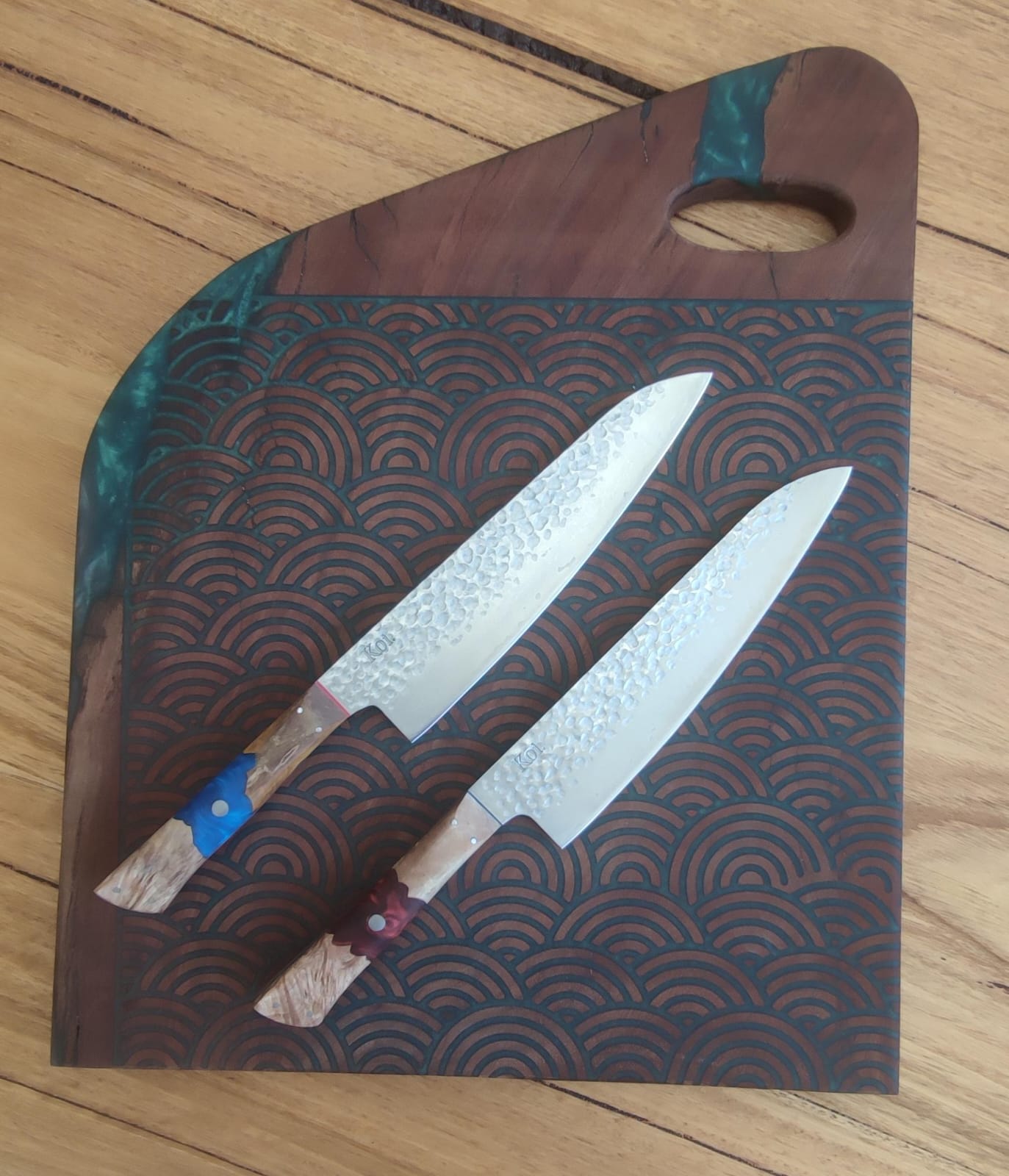Proper knife storage is an often-overlooked aspect of knife care that plays a vital role in preserving their sharpness, longevity, and overall safety. Neglecting to store knives correctly can lead to dull blades, potential accidents, and premature wear and tear. This comprehensive guide explores various storage options, provides cleaning and maintenance tips, and equips you with the knowledge to keep your blades sharp and secure.

Understanding the Impact of Improper Knife Storage
Proper knife storage is more than just a matter of convenience; it plays a crucial role in maintaining your knives' performance and safety. Failing to store them correctly can lead to many issues that compromise their functionality and longevity.
Risks to Knife Performance
Improper storage exposes knives to various risks that can negatively impact their performance. One significant risk is blade damage, which can occur when knives are stored in crowded, unprotected environments. Blade-to-blade contact can cause nicks, scratches, and even dulling, reducing the effectiveness of your knives when it matters most.
Additionally, exposure to moisture and humidity due to inadequate storage can lead to corrosion, affecting the blade's sharpness and overall cutting ability.

Common Issues Caused by Incorrect Storage Practices
Improper knife storage practices often result in common issues that can hinder their functionality and pose safety risks. One such issue is the dulling of blades over time. Storing knives without blade covers or in contact with other utensils or hard surfaces can lead to blunt edges, requiring frequent sharpening and diminishing cutting efficiency.
Another concern is accidental cuts and injuries. Placing knives loosely in drawers or countertops increases the likelihood of accidentally coming into contact with the sharp blades, risking harm to yourself or others.
Let's explore different storage options, cleaning and maintenance tips, and safety practices to ensure your knives remain in optimal condition for extended periods.

Different Storage Options for Knives
When storing your knives, several options are available, each with benefits and considerations. Choosing the right storage solution keeps your knives organized and helps maintain their sharpness and longevity. Let's explore three popular storage options: magnetic knife strips, knife blocks, and drawer inserts/tray systems.
Magnetic Knife Strips
Magnetic knife strips offer a sleek and space-saving storage solution that showcases your knives while keeping them easily accessible. The magnetic strip securely holds the knives in place, eliminating the need for knife blocks or drawers.
Benefits and Considerations:
- Enhanced visibility: Displaying your knives on a wall-mounted magnetic strip allows for quick identification and easy access during food preparation.
- Space efficiency: Using vertical wall space, magnetic strips help maximize countertop or drawer space.
- Hygiene advantages: Unlike knife blocks, magnetic strips prevent moisture build-up, reducing the risk of bacterial growth.
Tips for Using Magnetic Strips Effectively:
- Positioning: Mount the strip at a convenient height, ensuring the knives are within reach but out of the reach of children.
- Weight distribution: Distribute the weight of the knives evenly along the strip to maintain balance and stability.
- Blade protection: To prevent scratches, ensure that the blade edges face away from the wall.

Knife Blocks
Knife blocks are a classic and popular storage option. They come in various designs, materials, and sizes, providing functionality and aesthetic appeal to your kitchen.
Advantages and Disadvantages:
- Organization and accessibility: Knife blocks offer designated slots for different types of knives, making locating and retrieving them easy.
- Blade protection: Knife blocks keep the blades safely nestled in the slots, protecting them from damage and dulling.
- Limited capacity: Depending on the size of the block, it may only accommodate a small collection of knives, limiting future expansion.

Best Practices for Knife Block Storage:
- Knife selection: Choose a knife block that accommodates your existing knives and provides room for future additions.
- Cleanliness: Regularly clean the knife block to remove dust, debris, and potential contaminants.
- Proper positioning: Place the knife block in a dry and ventilated area away from heat sources to prevent moisture build-up.

Drawer Inserts and Tray Systems
Drawer inserts and tray systems offer a practical and organized storage solution for those who prefer to keep their knives tucked away in a drawer.
Features and Benefits:
- Customization: Drawer inserts and tray systems come in various sizes and configurations, allowing you to create a personalized setup that suits your knife collection.
- Space utilization: You can free up valuable countertop space by utilizing drawer space.
- Protection and organization: Insert with individual slots or separate dividers prevent blade-on-blade contact that can lead to damage.
Organizational Tips for Drawer Storage:
- Proper placement: Arrange the knives in the drawer so each blade is protected and easily visible upon opening.
- Secure placement: Ensure the knives are snugly fit in their designated slots to prevent movement and potential accidents.
- Regular maintenance: Clean the drawer regularly to remove any debris or moisture affecting the knives' condition.
Cleaning and Maintenance Tips for Stored Knives
Proper cleaning and maintenance are crucial to ensure your stored knives remain in optimal condition. Follow these expert tips to keep your knives sharp and ready for use:
Proper Cleaning Techniques
Cleaning your knives after each use is essential. Use mild dish soap and warm water to gently clean the blade, avoiding harsh abrasives that can damage the finish. Rinse thoroughly and dry with a soft cloth to prevent moisture buildup and potential rusting.
Drying and Oiling Knives before Storage
Ensure your knives are fully dry before being put away to keep them from rusting. Consider putting a thin coat of mineral oil safe for food on the blade. This will protect it from moisture and rust.
The Role of Honing and Sharpening in Knife Maintenance
Regular honing and sharpening are vital for maintaining knife performance. Honing realigns the blade edge while sharpening removes metal to restore the sharpness. Use a honing rod for quick touch-ups between sharpening sessions, and invest in quality sharpening tools or professional services when needed.
Introducing the KOI New Fan Rack
Koi Knives are renowned for their exceptional craftsmanship and cutting-edge design, making them popular among culinary enthusiasts. With their razor-sharp blades and exquisite handles, these knives deserve special attention regarding storage. That's where the innovative Koi Knives Fan Rack comes into play.

Designed to showcase your Koi Knives collection while ensuring optimal safety and accessibility, the Fan Rack is a game-changer. Its unique fan-shaped design lets you display your knives beautifully while the individual slots securely hold each blade. This minimizes the risk of accidental damage and provides a captivating visual display in your kitchen.
To maximise the benefits of the Fan Rack, consider these tips. First, arrange the knives to allow easy identification and retrieval. Additionally, ensure the blades are facing inward to prevent accidental contact. Finally, regularly clean and inspect the Fan Rack to maintain its pristine condition.

With the Koi Knives Fan Rack, you can elevate your knife storage to elegance and practicality, ensuring your prized blades are safeguarded and showcased. Embrace this innovative solution and take your culinary artistry to greater heights.
Conclusion
Proper knife storage is crucial for maintaining the performance and safety of your valuable blades. By understanding the impact of improper storage and implementing the right techniques, you can ensure that your knives remain in top condition for extended periods.
Explore the various storage options, such as magnetic knife strips, knife blocks, and drawer inserts, to find the best fit for your needs. Remember to prioritize cleaning, maintenance, and safety practices to maximise the lifespan of your knives and prevent accidents.





